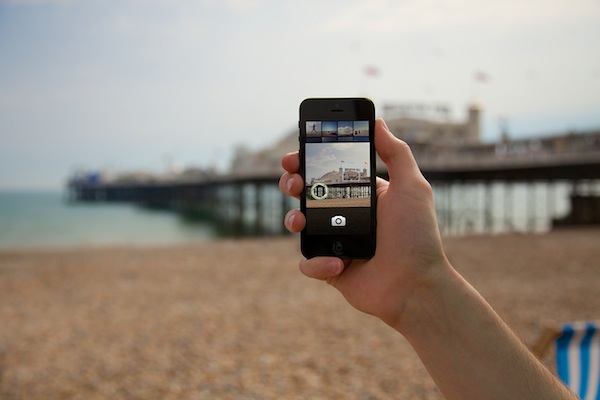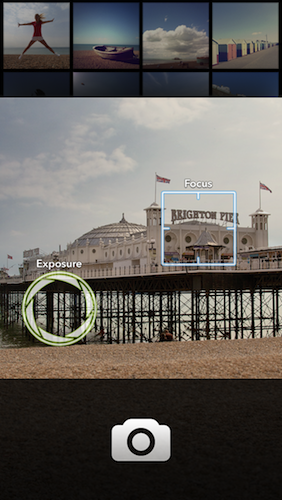Through a simple card, Analog Camera introduces itself with a short tutorial and animated image, explaining how to set exposure and autofocus. Personally, I wanted to fool around with the app before I read the manual, seeing if I could discover which gestures did what and whether I could navigate the app without having getting frustrated or lost. I took the same approach with Clear, Realmac Software’s earlier collaborative effort on iOS, and ultimately determined that there was enough feedback and freedom to figure it out on your own. So I dismissed the card, and would have to do so a few more times as I got around to viewing different parts of the app.
Realmac Software is pitching Analog Camera as an app that gets the camera out of your way and your photos onto social networks like Twitter, Instagram, and Facebook very quickly. The app itself is basically a sort of Instagram-Mini, featuring square cropped photos and a selection of handpicked filters (of which there are eight) while lacking social features like profiles and comments. As you take pictures, chimes increase in pitch, and as you swipe through the interface you might hear sounds reminiscent of Letterpress. I think a xylophone plays as you exit the sharing menu.
Having snapped a few pictures after the brief tutorial, I began working my way through the selection of photos. Tapping on photos taken with the app will bring you to the sharing menu, where you can pick a filter and send the photo off. If you pick a foreign photo taken outside of Analog Camera, you have to crop the photo into a square format. Realmac Software says that the square format is to make sharing to social networks easier, but it seems to me that Instagram is the only beneficiary.
Maybe the square format is forced so that the camera’s viewfinder only takes up part of the screen, reinforcing the idea that Analog Camera is gesturally driven. The viewfinder itself has no frame — you can tap on it to focus, tap with two fingers to set exposure and focus separately, and double tap to let your iPhone decide how to take the picture. A horizontal line helps you line up your shot. Otherwise, there’s no extra frills for flash or optical zoom. It can be dismissed with a simple downward flick, revealing photos from the Camera Roll and from Photo Stream. As a nice touch they’re sorted by having the most recent photos first. A behavior I don’t like: tapping on a photo behind the viewfinder while the camera is active selects the photo — I feel it should dismiss the camera instead. The camera itself does take pictures very quickly as promised.
The eight filters that analog camera provides are the same kind of vintage nostalgic throwbacks we’re accustomed to by now. A black and white filter stands out, but the rest seem to be rather nuanced, one being more washed out or another being more saturated, but all sharing the same sort of backbone of similarly faded colors and soft overblown exposures.
In Analog’s introductory video, Realmac Software showed off the idea that you can quickly select a filter by dragging your thumb to select the one you want. As you let go, the image fills the display, and you can tap to dismiss it or choose to share it. Practically, you can just tap on the filter you want. If you’d like to leave the menu to get back to the camera or choose another photo, you have to pull down to slide the camera and photo browser back into view. While this behavior was common in Clear, it didn’t depict the interaction as loading or refreshing the interface, which I don’t think is appropriate here (Analog draws its pinwheel as you pull down, giving said impression).
The share menu is interesting, as it reorganizes itself based on what you have installed and whether you have your Twitter or Facebook accounts plugged into iOS. For example, you can share to Dropbox or Google Drive if you want, but you can’t just take these photos anywhere. Images shared or sent from Analog Camera have their own proprietary format, although you can still export them traditionally to the Camera Roll if you want to work around it. Hopefully that will be changed in a future update — there’s no reason why images shared to a cloud storage app shouldn’t be a basic JPEG.
Analog Camera is a fun app, designed and marketed to be fun, and that clearly shows. It has a charm that reflects the kind of design language we’ve seen from Realmac Software lately, from the colorful icon down to flicking the camera away on a whim. I think it is a fast camera app that’s entirely social, but I do wonder if some of the gestures are an absolute necessity. The app is polished and the details are there, but I don’t feel gestures improve the effectiveness of the camera or that the app solves any previous difficulties in taking pictures or sharing. I don’t think this is by any means an Instagram replacement or alternative, but rather a companion, which is where I think this app fits nicely for $0.99.
You can learn more and download Analog Camera from the App Store.




